Since the publication of the NACTO Urban Bikeway Design Guide, NACTO has released additional guidance on facility selection where goals include high-comfort or all-ages bicycling.
See this new resource >
Description
Bike lanes designate an exclusive space for bicyclists through the use of pavement markings and signage. The bike lane is located adjacent to motor vehicle travel lanes and flows in the same direction as motor vehicle traffic. Bike lanes are typically on the right side of the street, between the adjacent travel lane and curb, road edge, or parking lane. This facility type may be located on the left side when installed on one-way streets, or may be buffered if space permits. See contra-flow bike lanes for a discussion of alternate direction flow.
Bike lanes enable bicyclists to ride at their preferred speed without interference from prevailing traffic conditions. Bike lanes also facilitate predictable behavior and movements between bicyclists and motorists. Bicyclists may leave the bike lane to pass other bicyclists, make left turns, avoid obstacles or debris, and avoid other conflicts with other users of the street.
Click on the images below to view 3D concepts of conventional bike lanes.
Treatment details can be accessed below under design guidance.
Conventional Bike Lane Benefits
- Increases bicyclist comfort and confidence on busy streets.
- Creates separation between bicyclists and automobiles.
- Increases predictability of bicyclist and motorist positioning and interaction.
- Increases total capacities of streets carrying mixed bicycle and motor vehicle traffic.
- Visually reminds motorists of bicyclists’ right to the street.
Typical Applications
- Bike lanes are most helpful on streets with ≥ 3,000 motor vehicle average daily traffic.
- Bike lanes are most helpful on streets with a posted speed ≥ 25 mph.
- On streets with high transit vehicle volume.
- On streets with high traffic volume, regular truck traffic, high parking turnover, or speed limit > 35 mph, consider treatments that provide greater separation between bicycles and motor traffic such as:
Design Guidance

Guidance below applies to street segments. See the Intersection Treatments section for guidance on the approach to intersections.
| Required Features |
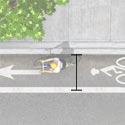 |
The desirable bike lane width adjacent to a curbface is 6 feet. The desirable ridable surface adjacent to a street edge or longitudinal joint is 4 feet, with a minimum width of 3 feet. In cities where illegal parking in bike lanes is an concern, 5 foot wide bike lanes may be preferred. Read More+
“The recommended width of a bike lane is 1.5m(5 feet) from the face of a curb or guardrail to the bike lane stripe.”
“If the [longitudinal] joint is not smooth, 1.2m(4 feet) of ridable surface should be provided.”
AASHTO. (1999). Guide for the Development of Bicycle Facilities.
|
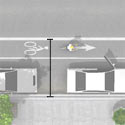 |
When placed adjacent to a parking lane, the desirable reach from the curb face to the edge of the bike lane (including the parking lane, bike lane, and optional buffer between them) is 14.5 feet; the absolute minimum reach is 12 feet. A bike lane next to a parking lane shall be at least 5 feet wide, unless there is a marked buffer between them. Wherever possible, minimize parking lane width in favor of increased bike lane width. Read More+
“If parking is permitted, … the bike lane should be placed between the parking area and the travel lane and have a minimum width of 1.5 m (5 feet).”
“Where parking is permitted but a parking stripe or stalls are not utilized, the shared area should be a minimum 3.6 m (12 feet) adjacent to a curb face … If the parking volume is substantial or turnover is high, an additional 0.3 to 0.6 m (1 to 2 feet) of width is desirable.”
AASHTO. (1999). Guide for the Development of Bicycle Facilities.
|
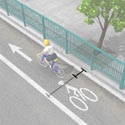 |
The desirable bike lane width adjacent to a guardrail or other physical barrier is 2 feet wider than otherwise in order to provide a minimum shy distance from the barrier. Read More+
“On new structures [with railings], the minimum clear width should be the same as the approach paved shared use path, plus the minimum 0.6-m (2-foot) wide clear areas.”
AASHTO. (1999). Guide for the Development of Bicycle Facilities.
|
 |
Bicycle lane word and/or symbol and arrow markings (MUTCD Figure 9C-3) shall be used to define the bike lane and designate that portion of the street for preferential use by bicyclists. Read More+
Markings shall be placed:
- At the beginning of bike lane
- At the far side of all bike path crossings
- At approaches and at far side of all arterial crossings
- At major changes in direction
- At intervals not to exceed ½ mile
- At beginning and end of bike lane pockets at approach to intersection
City of Los Angeles. (2011). 2010 Bicycle Plan Technical Design Handbook.
|
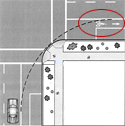 |
Bike lane word, symbol, and/or arrow markings (MUTCD Figure 9C-3) shall be placed outside of the motor vehicle tread path at intersections, driveways, and merging areas in order to minimize wear from the motor vehicle path. |
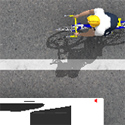 |
A solid white lane line marking shall be used to separate motor vehicle travel lanes from the bike lane. Most jurisdictions use a 6 to 8 inch line. Read More+
“A bike lane should be delineated from the motor vehicle travel lanes with a 150-mm (6-inch) solid white line. Some jurisdictions have used a 200-mm (8-inch) line for added distinction.”
AASHTO. (1999). Guide for the Development of Bicycle Facilities.
|
 |
A through bike lane shall not be positioned to the right of a right turn only lane or to the left of a left turn only lane (MUTCD 9C.04). A bike lane may be positioned to the right of a right turn only lane if split-phase signal timing is used. For additional information, see bicycle signal heads. For additional strategies for managing bikeways and right turn lanes, see through bike lanes in this guide. |
| Recommended Features |
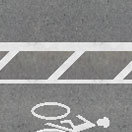 |
Bike lanes should be made wider than minimum widths wherever possible to provide space for bicyclists to ride side-by-side and in comfort. If sufficient space exists to exceed desirable widths, see buffered bike lanes. Very wide bike lanes may encourage illegal parking or motor vehicle use of the bike lane. |
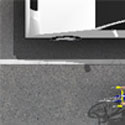 |
When placed adjacent to parking, a solid white line marking of 4 inch width should be used between the parking lane and the bike lane to minimize encroachment of parked cars into the bike lane. Read More+
“An additional 100-mm (4-inch) solid white line can be placed between the parking lane and the bike lane. This second line will encourage parking closer to the curb, providing added separation from motor vehicles, and where parking is light it can discourage motorists from using the bike lane as a through travel lane.”
AASHTO. (1999). Guide for the Development of Bicycle Facilities.
In a case study looking at the influence of pavement markings and bicyclist positioning, researchers found that, “the bicycle lane [with an edge line demarcating the parking lane] was the most effective at keeping cars parked closer to the curb and encouraging cyclists to ride in a consistent position at intersections.”
Pedestrian and Bicycle Information Center. (2006). BIKESAFE: Bicycle Countermeasure Selection System. Publication No. FHWA-SA-05-006, Federal Highway Administration, Washington, DC.
|
 |
Gutter seams, drainage inlets, and utility covers should be flush with the ground and oriented to prevent conflicts with bicycle tires. Read More+
“Since bicyclists usually tend to ride a distance of 0.8-1.0 m (32-40 inches) from a curb face, it is very important that the pavement surface in this zone be smooth and free of structures. Drain inlets and utility covers that extend into this area may cause bicyclists to swerve, and have the effect of reducing the usable width of the lane. Where these structures exist, the bike lane width may need to be adjusted accordingly.”
AASHTO. (1999). Guide for the Development of Bicycle Facilities.
|
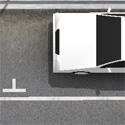 |
If sufficient space exists, separation should be provided between bike lane striping and parking boundary markings to reduce door zone conflicts. Providing a wide parking lane may offer similar benefits. Refer to buffered bike lanes for additional strategies. |
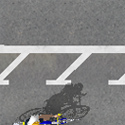 |
If sufficient space exists and increased separation from motor vehicle travel is desired, a travel side buffer should be used. Refer to buffered bike lanes for additional details. |
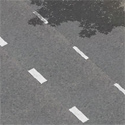 |
Lane striping should be dashed through high traffic merging areas. See through bike lanes for more information. |
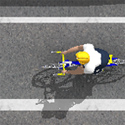 |
The desirable dimensions should be used unless other street elements (e.g., travel lanes, medians, median offsets) have been reduced to their minimum dimensions. |
 |
In cities where local vehicle codes require motor vehicles to merge into the bike lane in advance of a turn movement, lane striping should be dashed from 50 to 200 feet in advance of intersections to the intersection. Different states have varying requirements. |
| Optional Features |
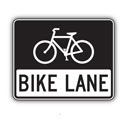 |
“Bike lane” signs (MUTCD R3-17) may be located prior to the beginning of a marked bike lane to designate that portion of the street for preferential use by bicyclists. The 2009 MUTCD lists bike lane signs as optional; however, some states still require their use. Read More+
“If the word, symbol, and/or arrow pavement markings shown in Figure 9C-3 are used, Bike Lane signs (see Section 9B.04) may also be used, but to avoid overuse of the signs not necessarily adjacent to every set of pavement markings.”
Federal Highway Administration. (2009). Manual on Uniform Traffic Control Devices.
|
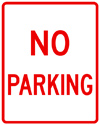 |
On bike lanes adjacent to a curb, “No Parking” signs (MUTCD R8-3) may be used to discourage parking within the bike lane. |
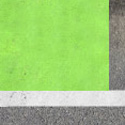 |
Color may be used to enhance visibility of a bike lane. |
Maintenance
- Lane lines and stencil markings should be maintained to clear and legible standards.
- Bike lanes should be plowed clear of snow by crews.
- Bike lanes should be maintained to be free of potholes, broken glass, and other debris.
- Utility cuts should be back-filled to the same degree of smoothness as the original surface. Take care not to leave ridges or other surface irregularities in the area where bicyclists ride.
- If chip sealing, consider providing new surfacing only to the edge of the bike lane. This results in a smoother surface for bicyclists with less debris. Sweep bike lanes clear of loose chip in the weeks following chip sealing.
- If trenching is to be done in the bike lane, the entire bike lane should be trenched so that there is not an uneven surface or longitudinal joints.
Treatment Adoption and Professional Consensus
Bicycle lanes are the most common bicycle facility in use in the US, and most jurisdictions are familiar with their design and application as described in the MUTCD and AASHTO Guide for the Development of Bicycle Facilities. To offer increased levels of comfort and security to bicyclists, some cities have exceeded the minimum dimensions required in these guides.